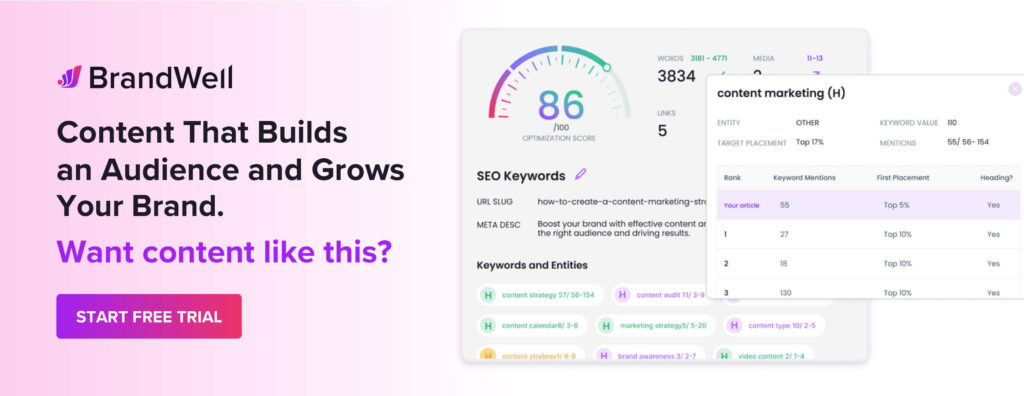Discover top guides, trends, tips and expertise from AIO Writers
Is AI Content Good for SEO in 2025? Pros, Cons & Strategies
Jeff Joyce
Monday, 20th Jan 2025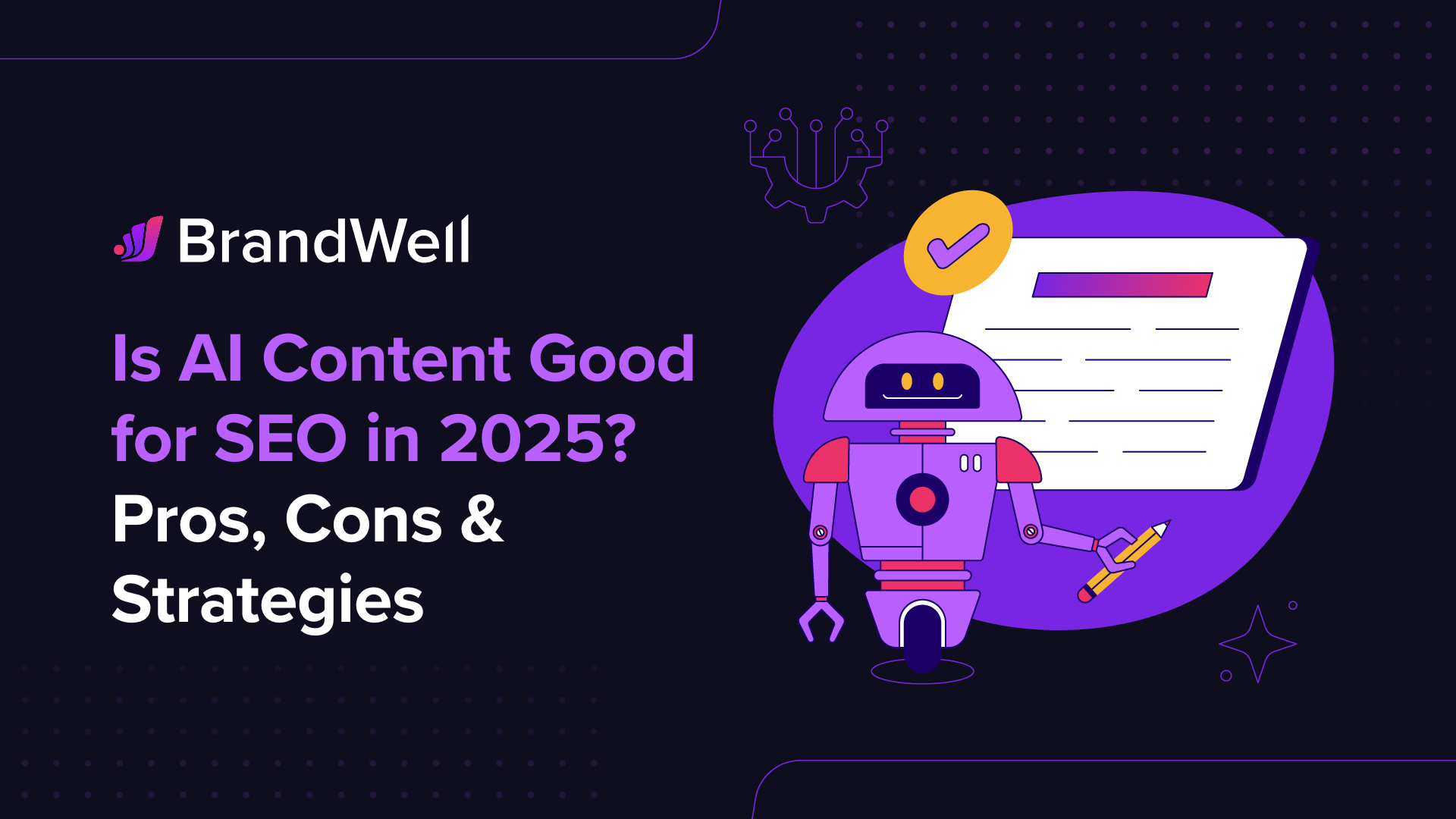
As we move deeper into 2025, artificial intelligence (AI) continues to revolutionize the digital landscape, including search engine optimization (SEO).
But is AI content good for SEO? Or does it present challenges that marketers need to navigate carefully?
The answer lies in how you use AI — strategically and responsibly — to complement your content creation efforts.
When used correctly, AI content can significantly enhance SEO efforts. However, over-reliance on AI-generated material without proper human oversight can lead to poor quality, generic content, and decreased user engagement — ultimately affecting your rankings.
In this post, we’ll explore both the positive aspects and potential drawbacks of using AI-generated content for SEO as well as best practices for adapting AI to your SEO strategy.
Table of Contents
What is AI Generated Content?
AI content is anything written (or created) using AI technology. This includes blog posts, images, social media captions, videos, and ebooks.
While the explosive growth of conversational chatbots like ChatGPT, Gemini, and Claude might make AI seem like the new kid on the block, it’s been impacting your Google searches for years.
The truth is Google began incorporating AI into Google Search with RankBrain as early as 2015.
These days, everybody’s talking about AI content. But is it good for SEO?
It’s tricky. Google says they want you to write for humans, not search engines. But they also want your site to load fast and be easy to understand.
That’s where AI can be helpful, but you gotta be careful.
Why AI Content is Good for SEO
AI technology has made remarkable strides in understanding language, user behavior, and content needs. Here are some ways AI can boost your SEO efforts:
1. Efficiency and Time Savings
The biggest benefit of using AI is that it can help you make a lot of content really fast.
Whereas it takes a human writer around 4 hours to write a single blog post, AI can do it in under 2 minutes.
This speed and efficiency are particularly beneficial for businesses that need to produce a high volume of content regularly. The rapid production can also help maintain a consistent posting schedule, which is critical for maintaining and improving SEO rankings.
Here are some ways AI content can benefit your SEO:
Generating Drafts Quickly
AI-powered writing tools like ChatGPT or BrandWell can produce well-structured drafts for blog posts, articles, or even product descriptions in minutes.
If you’re running an e-commerce site, you could use these tools to write hundreds of unique product descriptions, freeing up time for marketers to focus on refining brand voice and tone.
Here’s a full SEO-ready draft written by BrandWell in under 10 minutes:
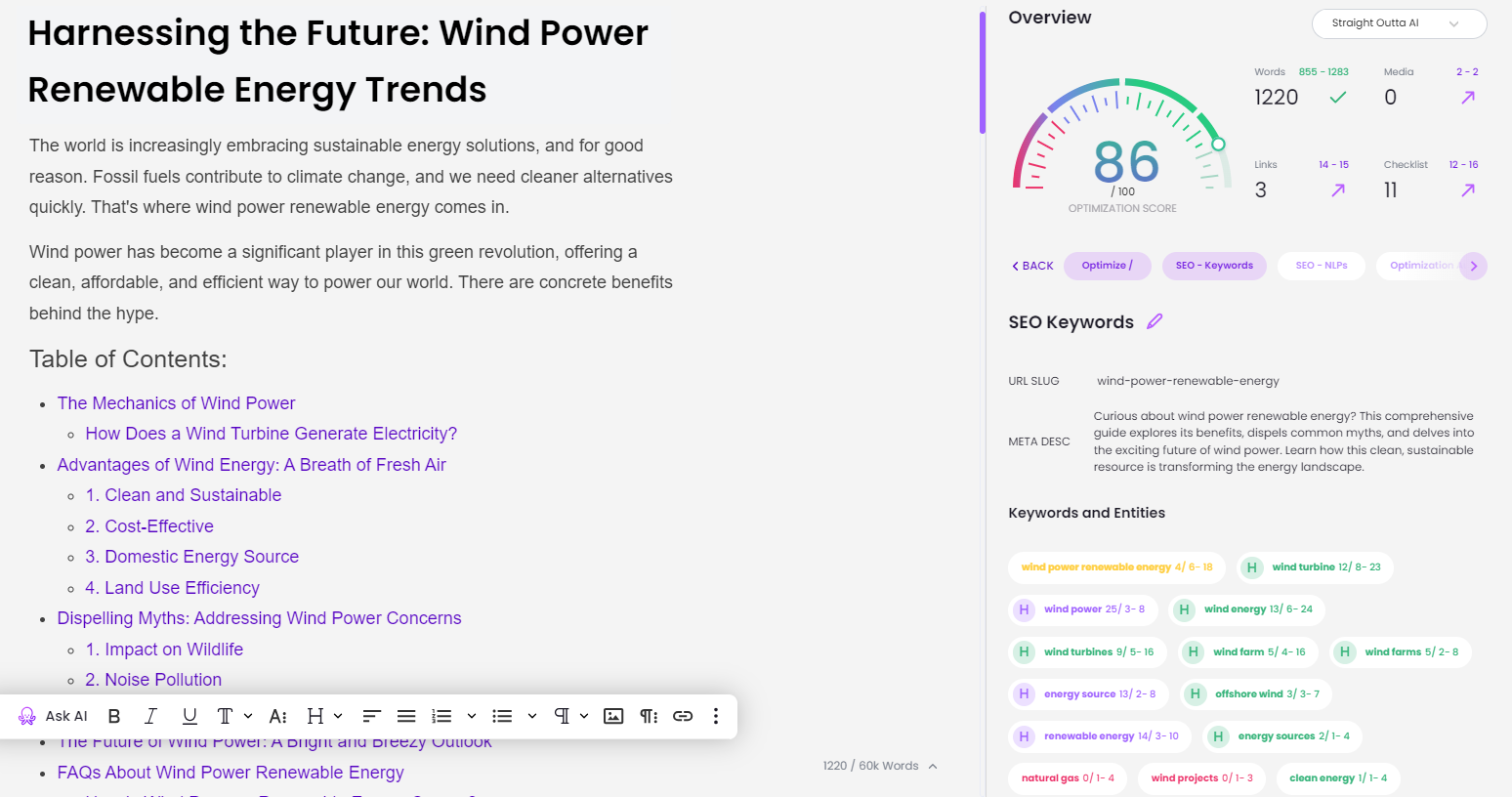
Keyword Suggestions and Optimization
Tools such as Semrush or BrandWell use AI to recommend relevant keywords and help structure content in ways that align with SEO best practices.
For example, a food blog targeting “quick weeknight dinners” could use AI suggestions to include related terms like “15-minute meals” or “easy dinner recipes” seamlessly into their content.
If you’re writing your blog post using BrandWell, you’ll see these keyword suggestions in the right column:
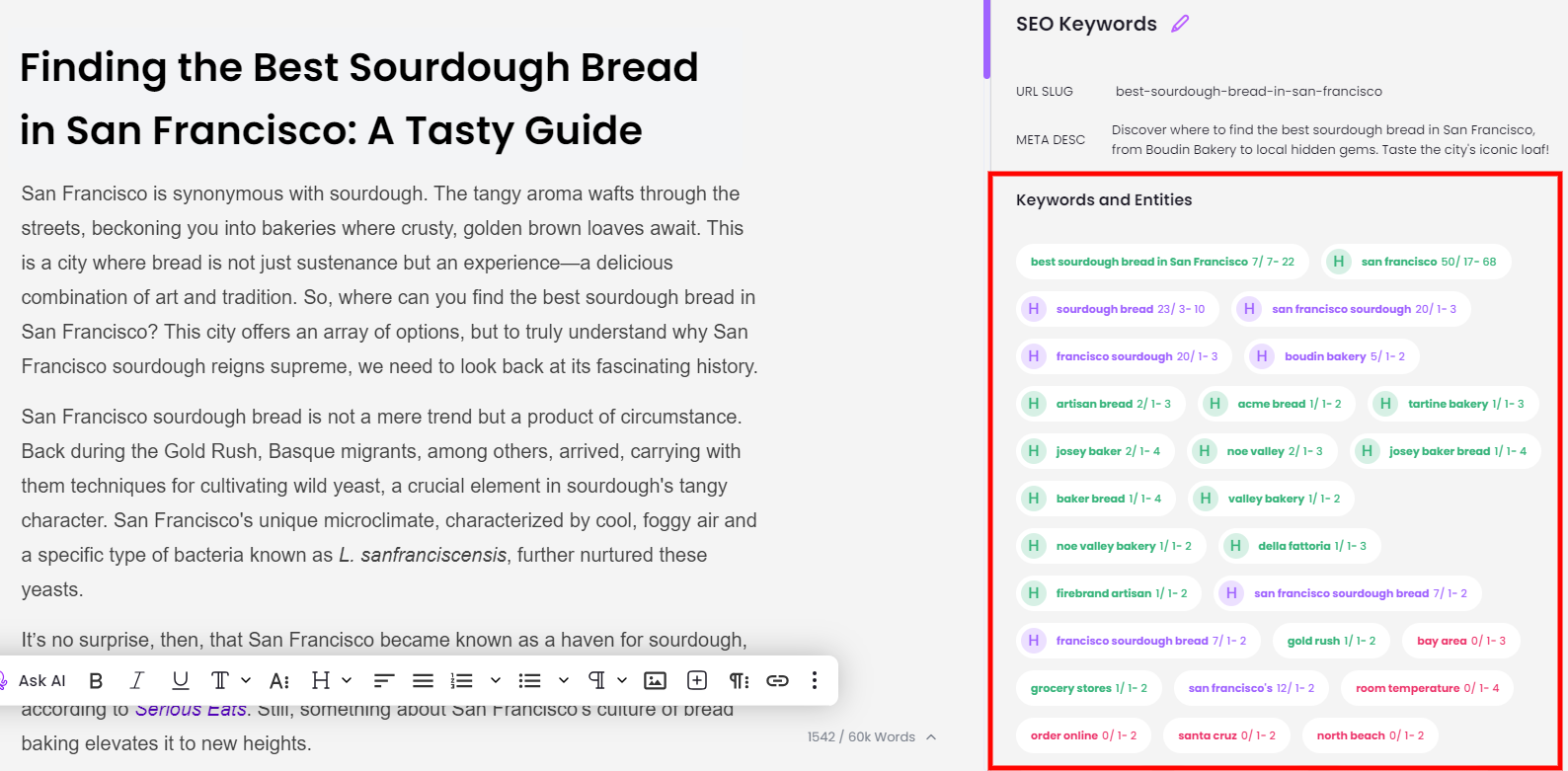
You can even run optimization audits while you are editing your article. Here’s an example of the audit report generated by BrandWell:
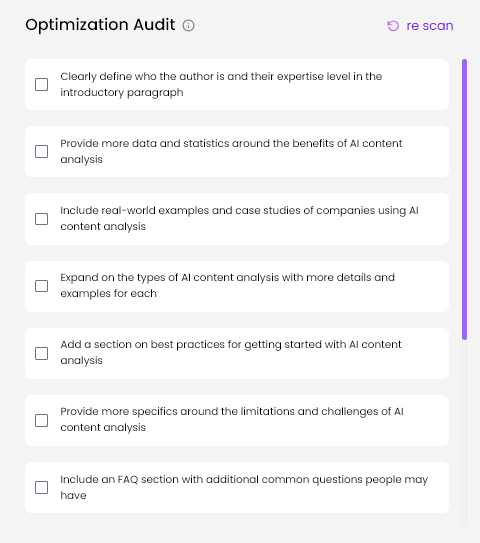
Automating Repetitive Tasks
AI can handle tasks like formatting, tagging, or creating metadata. A small business owner managing their website can automate the creation of SEO-optimized meta titles and meta descriptions for hundreds of pages using tools like BrandWell, saving hours of manual work.
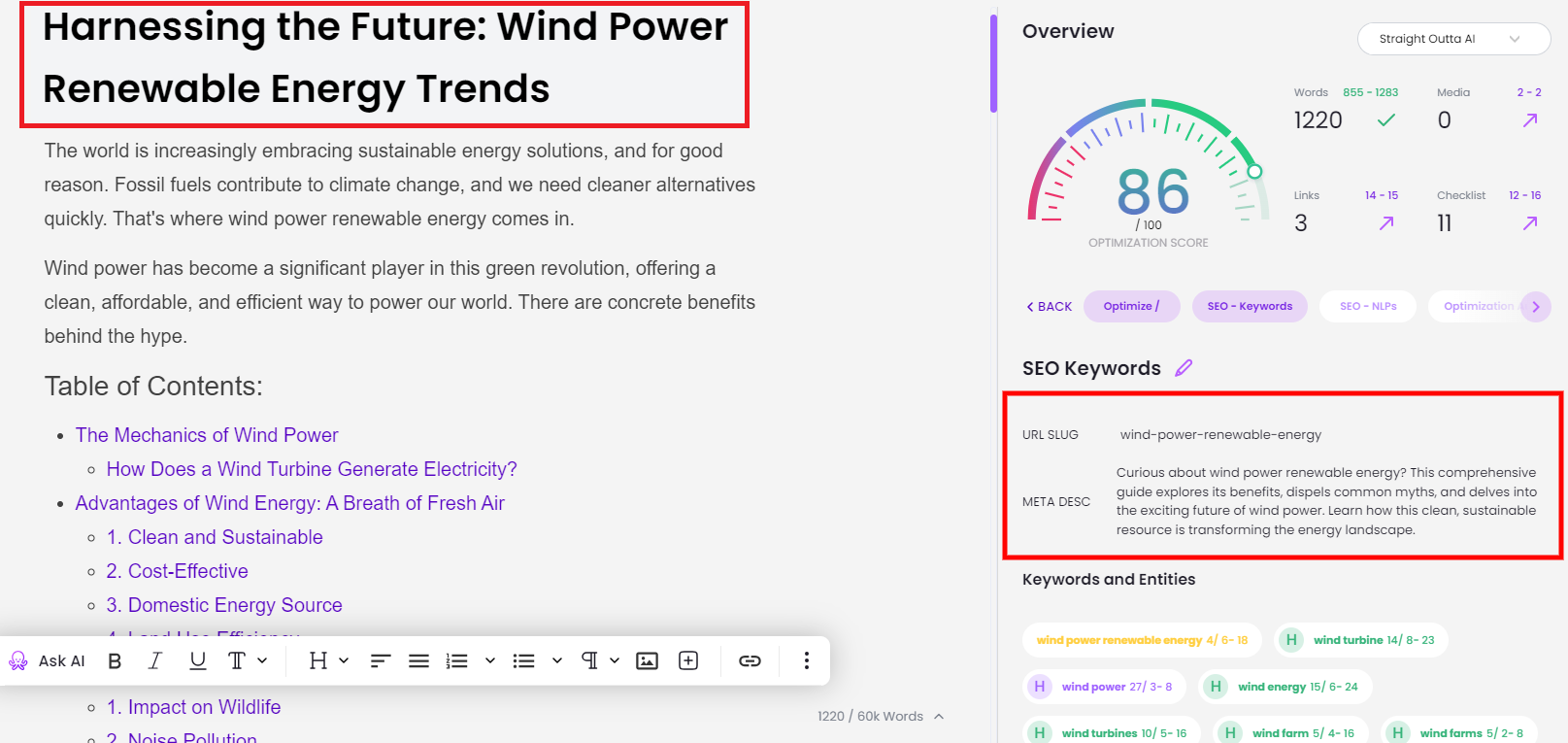
By integrating these AI-driven approaches into your workflow, you’ll be able to focus more on strategic decisions and creative storytelling rather than getting bogged down by routine tasks.
2. Better Understanding of User Intent
One of the most powerful ways AI can enhance SEO is by helping content creators better understand and align their material with user intent.
User intent refers to the reason behind a user’s search query — what they are hoping to find or achieve when typing in a specific keyword or phrase. Understanding and addressing this intent is crucial for ranking high on search engine results pages (SERPs).
In the past, SEO was largely about optimizing content with specific keywords. However, Google’s algorithms have evolved to focus more on the intent behind a search query rather than just the keywords themselves. AI, with its ability to analyze large volumes of search data, is particularly effective in interpreting and addressing user intent. By leveraging AI tools to analyze search patterns, AI can predict and adapt content creation to meet users’ exact needs.
There are three main categories of user intent:
- Informational Intent: The user is looking for information on a specific topic.
- Navigational Intent: The user is trying to find a particular website or page.
- Transactional Intent: The user is ready to make a purchase or engage in a transaction.
AI can analyze search query patterns and user behavior to create content that aligns with these different intents, ensuring higher relevancy for search results.
Here are some ways AI can help match your content with user intent:
Analyze Search Trends
AI can quickly sift through vast amounts of search data to identify emerging trends and shifts in user behavior. Tools like Google’s RankBrain or AI-driven platforms like Clearscope and MarketMuse can analyze what users are typing into search engines and recognize the subtleties in their queries. By doing so, AI can identify not only the keywords people use but also the context and purpose of their searches.
For example, if AI detects a surge in searches for “best home workout equipment for small spaces,” this signals informational intent. The AI can suggest creating content around this query that addresses the benefits, drawbacks, and considerations of workout gear specifically for small apartments.
Contextualize Long-Tail Keywords
AI excels at understanding long-tail keywords (longer, more specific search phrases), which can provide deeper insights into user intent. While a search for “laptops” could indicate broad interest, a search for “best laptops for students on a budget 2025” has more specific informational intent. AI can help generate content that speaks directly to these more detailed queries, making it more likely to match the user’s expectations.
For example, a long-tail query like “how to bake gluten-free bread for beginners” indicates clear informational intent. An AI tool could analyze this phrase and suggest content that addresses beginner tips, common mistakes, necessary ingredients, and basic recipes, ensuring the content aligns closely with what users are seeking.
Understand Searcher Behavior
AI can track and analyze how users interact with search results and content. By observing which types of content get the most engagement, such as clicks, time on page, and bounce rates, AI can refine its understanding of what users are truly looking for. This behavioral analysis helps create content that anticipates the needs of users more accurately.
For example, if an AI tool identifies that articles with step-by-step guides on a specific topic (e.g., “how to start a podcast from scratch”) result in higher engagement, it could suggest similarly structuring your content. If the AI notices that users tend to click on articles that feature personal experiences or case studies, this insight could help you tailor your approach, emphasizing practical examples and clear, easy-to-follow instructions.
Generate Topic Ideas Based on User Queries
AI tools can analyze user queries and generate topic ideas that are directly aligned with the kinds of content users are seeking. Rather than simply responding to broad queries, AI can suggest content that fills gaps in current search results. This helps content creators produce material that directly addresses the most relevant questions and needs in a particular niche or industry.
For example, a search query like “how does AI affect SEO rankings” reflects a mix of informational and transactional intent. AI can analyze existing content and identify the best opportunities for a deeper, more insightful article that explores the nuances of AI in SEO, possibly even creating subsections that explain the topic from both a beginner and expert perspective.
Personalize Content Based on User Profiles
AI can also leverage user data and profiles to create more personalized content. By analyzing past search behaviors, demographics, or interactions with a website, AI can help craft content that feels tailored to specific users. This enhances user engagement and increases the likelihood of conversions or return visits.
Imagine a user who frequently searches for eco-friendly products. AI can help create personalized content around “eco-friendly gadgets for tech lovers” or “best sustainable materials for home products,” catering to this specific user profile. Personalization drives greater relevance, improving user satisfaction and SEO performance.
AI doesn’t just help in understanding the search query itself; it also aids in structuring the content to make it more user-centric. Advanced AI tools like BrandWell suggest optimal content structures based on search patterns, enhancing how content is presented. For example, it may suggest using bullet points for step-by-step guides or incorporating video for visual explanations of complex topics.
By matching the structure to what users expect, AI can improve content’s usability, which in turn boosts rankings. Google’s algorithms value well-structured content that improves the user experience, which is why AI tools that optimize content layout according to user intent can contribute to better SEO outcomes.
3. Content Diversification
In 2025, content diversification is a critical strategy for improving SEO, and AI is playing a pivotal role in enabling businesses to efficiently produce a wide range of content formats.
Google’s algorithms are now more sophisticated than ever, recognizing and rewarding diverse content formats that cater to varied user needs. As the demand for multimedia content continues to rise, businesses must adapt their content strategies to include not just blog posts but also videos, podcasts, images, and other interactive formats.
AI tools can help streamline and enhance content diversification by generating different content forms from a single idea, topic, or piece of text. This approach helps content marketers extend the reach of their content, attract diverse audiences, and improve overall SEO performance.
How can AI help diversify your content?
Reach Different Audiences
Different users consume content in various ways. Some may prefer reading blog posts, while others may be more inclined to watch videos or listen to podcasts. By diversifying content formats, you increase the likelihood of reaching a broader audience.
For example, younger users may prefer videos or social media content over written articles, while more in-depth explanations or guides may be better suited for blog posts.
Appeal to Rich Snippets and Featured Snippets
Google’s rich snippets and featured snippets often pull from varied content formats, including videos, FAQs, and how-to guides. Content diversification helps you rank in these special placements by providing more structured, varied content that Google can easily pull from.
Higher Engagement and User Retention
Diverse content keeps users engaged by offering them a variety of content types, which can lead to longer time on site and repeat visits. For example, a user who initially reads a blog post might stay longer to watch a related video, thus increasing overall engagement metrics that positively impact SEO.
Improved Brand Visibility Across Multiple Platforms
By diversifying content, you can ensure your brand appears on multiple platforms — whether that’s YouTube, social media, podcast directories, or other content hubs. AI can help you efficiently repurpose content for different platforms, increasing your brand’s visibility and engagement across a variety of channels.
Imagine a blog post titled “10 Tips for Digital Marketing in 2025.” Using AI, you can repurpose this content into a video script, with AI recommending a breakdown of each tip into a visual format, complete with images, animations, or on-screen text. This video could be optimized for YouTube with proper metadata, and the same tips can be posted as bite-sized social media posts on platforms like Instagram or LinkedIn.
AI can also transform a detailed blog post into various social media posts. For example, AI can generate Twitter threads, LinkedIn posts, Instagram captions, or Facebook statuses based on the key takeaways from an article. These social posts can include relevant hashtags and calls-to-action (CTAs) to drive traffic back to your main content.
AI can turn long-form content into podcast episodes as well, allowing you to create audio content for users who prefer listening over reading. AI can help craft conversational scripts that summarize blog posts or delve deeper into the topics discussed, adding more context and discussion points that make it suitable for podcast audiences.
Using AI, you can take key sections of a blog post or video and convert them into email newsletters or promotional material. The AI can suggest the most compelling lines or data points to use, ensuring that the content resonates with subscribers and drives clicks back to the website.
Lastly, AI-driven design tools can help convert textual content into infographics, data visualizations, or other visual assets that engage users visually. These visual elements are often more shareable and have the potential to go viral on social platforms, further increasing visibility and engagement. Infographics also tend to rank well in Google’s image search, driving additional organic traffic.
By using AI to create a variety of content types, you ensure that your content caters to different stages of the customer journey, from informational queries to decision-making.
4. Data-Driven Insights
In 2025, the use of data-driven insights is one of the most significant ways that AI is shaping SEO strategies.
Data-driven decision-making allows businesses to refine their SEO efforts and optimize content creation in ways that directly align with user preferences, trends, and search behavior.
Here are more benefits of data-driven insights for SEO:
Refine Keyword Strategy
AI-powered tools can analyze large datasets from search engines to determine which keywords are driving the most traffic and which keywords are gaining popularity. By understanding search trends, you can optimize your content to target high-value keywords while identifying opportunities for long-tail keywords that are less competitive but highly relevant to your audience.
Identify Content Gaps
AI tools can analyze the content on your website as well as competitor sites to identify gaps in coverage. By pinpointing areas where there is a lack of detailed, high-quality content, AI can suggest topics to target that are likely to attract more traffic and engage users.
Enhance User Experience (UX)
By analyzing user behavior on your site, AI can provide valuable insights into how visitors are interacting with your content.
For example, AI can identify which pages are receiving the most engagement, where users drop off, or which pages have high bounce rates. This data can be used to optimize the website layout, content structure, and overall user experience to reduce bounce rates and increase time on page — both of which are critical factors for SEO.
Competitor Analysis
AI can perform competitor analysis by examining the content, backlinks, and keyword strategies of competing websites. By comparing your performance to that of competitors, AI can uncover weaknesses and opportunities in your content strategy.
Suppose a competitor’s article on “Best Practices for Remote Teams” is ranking high, but the content is mostly general advice without much value-added detail. AI can flag this opportunity, allowing you to create a more in-depth article that includes up-to-date tools, case studies, and expert opinions, thus providing more value to users and increasing your chances of outranking your competitor.
Learn more about mastering competitor analysis in this comprehensive guide.
Predict Future Trends
Lastly, AI can analyze historical search data to identify patterns and predict future trends. By understanding the trajectory of certain keywords or topics, AI helps content creators stay ahead of the curve and produce content that anticipates user interest. This predictive capability allows for proactive content creation, keeping your site fresh and relevant.
5. Cost-Effectiveness
One of the most appealing aspects of leveraging AI for SEO in 2025 is the cost-effectiveness it offers. While the initial investment in AI tools may seem substantial, the long-term savings and efficiency gains often outweigh the costs.
By automating tasks that traditionally require a significant amount of time and human resources, AI allows businesses to maximize their marketing budgets, reduce operational expenses, and focus on higher-value tasks.
In the fast-paced world of digital marketing, where content creation and SEO strategies must evolve quickly to stay competitive, AI can act as a force multiplier. It allows teams — whether small startups or large enterprises — to scale their SEO efforts without the need to constantly expand their workforce or outsource tasks.
Here are some ways you can save resources with AI:
Reduced Need for Outsourcing
Many businesses rely on external agencies or freelance experts to handle content creation, SEO analysis, and optimization. While outsourcing can be valuable, it often comes with significant costs.
AI tools help reduce this dependency by offering in-house teams the ability to perform these tasks themselves with the assistance of automated platforms. AI can support content creation, keyword research, data analysis, and reporting, cutting the need for third-party agencies or additional staff.
Scalability
For small businesses and startups, scaling SEO efforts without hiring additional staff can be a challenge. AI provides a solution by enabling teams to scale their content and SEO strategies rapidly without significantly increasing overhead costs.
AI-powered tools like BrandWell can generate large amounts of content or optimize entire websites quickly, making it easier for small teams to compete with larger, more resource-intensive organizations.
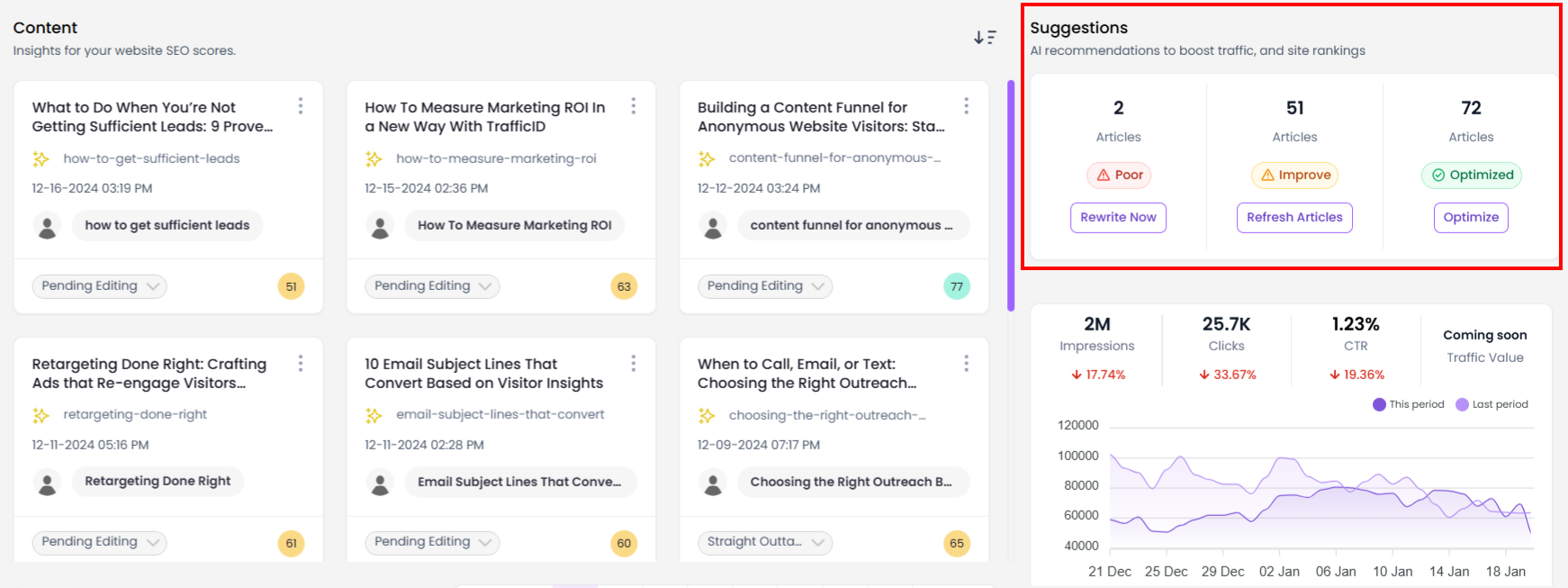
Improved Budget Allocation
AI-driven insights allow for more precise decision-making in SEO campaigns. Instead of guessing where to invest your resources, AI can help identify the most cost-effective strategies by analyzing the performance of various keywords, content types, and traffic sources. This allows businesses to allocate their budget more efficiently, investing in the most effective tactics and avoiding wasteful spending on low-performing areas.
Why AI Content is Bad for SEO
Now how can AI content hurt your SEO?
1. Generic and Repetitive Content
While AI can be a powerful tool for content creation, one of the biggest challenges in using AI for SEO is the risk of generating generic or repetitive content.
Since AI tools often rely on large datasets and algorithms to generate text, there is a potential for the output to lack uniqueness or originality.
Without proper oversight and customization, AI-generated content can sometimes feel formulaic, uninspired, or indistinguishable from content produced by other tools. This can lead to poor user engagement, higher bounce rates, and diminished SEO performance.
For SEO, generic content can be a major issue because search engines like Google prioritize high-quality, valuable, and unique content. If AI-generated content is too similar to what already exists online or doesn’t offer fresh insights, it can fail to attract or engage users, ultimately harming a website’s search rankings.
In 2025, when SEO is more competitive than ever, standing out from the crowd requires offering content that provides true value and originality.
How can generic, repetitive content tank your rankings?
Lack of Originality
AI tools can quickly generate content by synthesizing existing information from various sources. However, this can result in content that is overly similar to what already exists, without adding new insights or unique perspectives. Google’s algorithms are becoming increasingly sophisticated at recognizing duplicate or overly similar content, and they tend to penalize websites that don’t provide original value.
Let’s say you’re using an AI writer to create an article on “The Benefits of Yoga.” If the tool pulls from widely available content that regurgitates basic information, your article might end up being very similar to hundreds of others already published on the same topic. Without a unique angle, fresh insights, or expert opinions, your content will struggle to stand out and may fail to rank well.
Repetitive Phrasing and Ideas
AI tools often rely on common phrases, structures, or templates when generating content. This can result in repetitive content where the same phrases, ideas, or structures are repeated throughout the text. In SEO, repetitive content can lead to a poor user experience, as readers may feel they’re reading the same points over and over again, reducing the chances of them engaging further with your content.
Let’s say you’re using AI to generate a series of blog posts on “How to Improve Your Marketing Strategy.” You might end up with multiple articles that all start with the same basic concepts, such as “Identify your target audience“ or “Set clear goals.” While these are valid points, they lack depth and variety, leading to a dull, repetitive experience for the reader.
Failure to Address User Intent
Another issue with generic AI content is that it may fail to address the specific needs of the target audience or the nuances of user intent. AI may generate text that seems relevant on the surface but doesn’t fully answer the specific questions or solve the problems that users are searching for. This lack of focus on user intent can lead to lower engagement and reduced SEO performance.
Imagine you’re writing a blog post about “Best SEO Practices for 2025.” If the AI generates generic content without understanding the evolving SEO landscape or without tailoring its advice to your audience’s level of expertise (beginner vs. advanced), it could miss the mark.
An AI-generated piece that simply repeats outdated SEO tips without offering specific, up-to-date strategies or deeper insights will fail to resonate with readers, reducing its chances of ranking highly.
Overuse of Common Keywords
AI tools can sometimes focus too heavily on keywords that are overly common or competitive, resulting in content that feels optimized for search engines rather than humans. While keyword optimization is crucial for SEO, overstuffing content with the same terms or variations can lead to keyword cannibalization and make the content sound forced or unnatural. Google’s algorithms can penalize websites that engage in keyword stuffing or produce content that lacks natural flow.
Suppose you’re using AI to write a blog post on “Digital Marketing Tips.” The AI might insert the keyword “digital marketing” or its variations too many times throughout the article in an attempt to optimize the content for SEO. If the content becomes overly stuffed with keywords like “digital marketing tips,” “digital marketing strategies,” and “how to do digital marketing,” it will make the writing feel awkward and repetitive, hurting both readability and SEO performance.
In 2025, the challenge of generating high-quality, original content remains a critical factor for SEO success. While AI can provide a great starting point, businesses must be proactive in refining and enhancing the content to ensure it offers value and resonates with their audience.
2. Potential for Poor Quality Information
One of the major risks of using AI-generated content for SEO in 2025 is the potential for poor-quality information.
While AI has made significant strides in its ability to generate human-like text, it is still prone to inaccuracies, outdated information, and lack of depth in certain topics. This can be detrimental to SEO efforts, as both search engines like Google and users prioritize high-quality, authoritative, and trustworthy content.
When AI generates poor-quality content, businesses risk publishing material that could mislead users, harm their credibility, or fail to satisfy search engine algorithms, leading to lower rankings.
In 2025, where user experience and expertise are more critical than ever in SEO, maintaining a high standard of content quality is essential.
Why poor quality information can be problematic in SEO:
Outdated Information
AI-generated content pulls from vast datasets, including existing articles, research papers, and other content available online. However, AI tools may not be able to distinguish between outdated and current information, meaning that content could reference old data or concepts that are no longer relevant. This can lead to inaccuracies, which not only frustrates users but can also result in Google penalizing websites that provide misleading or outdated content.
Let’s say you’re using an AI tool to write an article about “SEO strategies for 2025.” The AI might pull data from older sources or articles published in previous years, providing advice based on outdated practices like keyword stuffing, which is now considered black-hat in modern SEO. If this content is published without review, users and search engines may view it as unreliable, resulting in poor rankings.
Lack of Depth or Detail
AI tools can be extremely efficient at generating text quickly, but the resulting content can often lack the depth, detail, or thoroughness required to satisfy both users and search engines. While AI is good at summarizing information, it may fail to explore a topic in sufficient detail, leading to shallow content that doesn’t fully address user queries or provide valuable insights.
Let’s say you’re using an AI tool to generate a blog post about “How to Build a Successful E-commerce Store.” The AI may provide a list of tips, but these tips could be generic and lack depth — such as simply suggesting “offer great customer service” or “optimize your website for mobile.” While these points are valid, they are not enough to provide real value to users who need actionable steps, resources, and case studies. As a result, the content feels incomplete and is unlikely to rank well on search engines.
Misleading or Inaccurate Claims
AI may sometimes generate content with factual errors, especially if it draws from unreliable or conflicting sources. While AI has been trained on vast amounts of data, it cannot independently verify the accuracy of the information it generates. This can result in content that makes misleading claims, presents incorrect statistics, or provides faulty advice.
Suppose an AI tool is asked to generate an article about “The Best Cloud Storage Services in 2025.” The AI might reference services that have been out of business or are no longer considered top contenders. It might also present inaccurate pricing information or outdated features that have since been upgraded or eliminated. Publishing this content could mislead users, diminish trust in the brand, and result in higher bounce rates.
Lack of Credible Sources or Citations
One of the hallmarks of high-quality SEO content is the inclusion of credible, authoritative sources that support the claims made in the article. AI tools, however, may generate content without properly attributing sources or providing citations. While it can provide generalized knowledge, AI may fail to reference the original sources, leaving content lacking the transparency and authority required to establish trust with readers and search engines.
An AI-generated article discussing “Top Strategies for Content Marketing in 2025” may present a series of strategies without citing any reputable sources. While the content may sound convincing, without authoritative references, it could be seen as less trustworthy. If readers or search engines recognize that the content lacks verifiable sources, it could negatively impact the site’s credibility and rankings.
Failure to Address Nuanced or Complex Topics
While AI is effective for generating content on straightforward topics, it may struggle when it comes to addressing nuanced or complex issues. Content that requires deep expertise or nuanced understanding — such as technical subjects, medical advice, legal matters, or scientific topics — can suffer from oversimplification or misrepresentation when generated by AI.
Imagine asking an AI tool to generate a post about “The Latest Advances in AI Technology.” The resulting content might provide a high-level overview but fail to cover the intricacies of emerging AI models, ethical concerns, or their implications for various industries. This shallow approach would be insufficient for readers seeking in-depth analysis or those with advanced knowledge of the field. For such topics, content that lacks depth can damage both user trust and SEO rankings.
By combining the speed and efficiency of AI with rigorous human oversight and expertise, businesses can avoid the pitfalls of poor-quality information. This approach not only ensures that content remains accurate, but also helps businesses maintain credibility, rank higher in search results, and deliver genuine value to their audiences.
3. Lack of a Human Touch
While AI-generated content has become increasingly sophisticated, it often lacks the emotional depth, personal connection, and nuanced storytelling that human-created content offers.
In 2025, users are not just searching for information; they crave meaningful and relatable content that feels tailored to their needs. AI’s inability to fully replicate the subtleties of human communication — such as empathy, humor, and cultural awareness — can result in content that feels impersonal or robotic, alienating audiences and diminishing trust.
Formulaic Blog Posts
Imagine an AI tool generating a blog post titled, “10 Tips for Managing Stress.” The tips might include suggestions like “exercise regularly,” “get enough sleep,” or “practice mindfulness.” While these points are valid, they are generic and lack the personal stories or unique insights that make readers feel understood.
A human writer might share a personal anecdote about overcoming stress through a specific mindfulness routine, adding a relatable and authentic perspective.
Emotionally Flat Customer Communications
AI can generate email responses or chatbot interactions, but these often lack the warmth or personalization of human interactions.
For instance, an AI-generated email response to a dissatisfied customer might say, “We’re sorry for the inconvenience caused.” While polite, this response feels robotic.
A human-written response might add empathetic language: “We understand how frustrating this must have been for you, and we’re committed to resolving this issue quickly.”
Lack of Cultural Sensitivity
AI tools may not fully understand cultural nuances or tailor content appropriately for specific audiences.
For example, a marketing campaign targeting a particular region might overlook cultural norms, idioms, or preferences, leading to messaging that feels out of place or insensitive. A human marketer familiar with the audience’s culture could craft content that aligns with local expectations and resonates more deeply.
By adding a human touch to AI-generated content, businesses can ensure their content not only ranks well for SEO but also builds meaningful connections with their audience.
4. Risk of Google Penalties
Using AI content for SEO can backfire if not executed properly. Search engines like Google often penalize websites that try to manipulate rankings through low-quality or spam-like practices.
While AI tools offer significant advantages in content creation, using them to mass-produce low-value content can lead to penalties that harm a site’s rankings and traffic.
In 2025, Google’s algorithms are more advanced than ever, capable of identifying and flagging content that lacks originality, expertise, or value to users. This makes it critical to use AI-generated content as part of a well-rounded strategy rather than a shortcut to flood search results with generic material.
What types of AI content does Google penalize?
Thin Content
Google defines “thin content” as pages with little or no added value for users. AI-generated content that is poorly curated or lacks depth may fall into this category. If Google’s algorithms detect that your site contains multiple pages with repetitive or superficial information, it may result in a manual or algorithmic penalty, reducing the site’s visibility in search results.
For example: a travel website uses AI to mass-produce location guides for various cities. If the guides are overly generic, with similar phrasing and minimal unique insights (e.g., visit the local markets, try the street food, enjoy the nightlife), Google may classify these pages as thin content. Without in-depth details, tips, or local expertise, such content adds little value and could harm the site’s rankings.
Duplicate Content
AI-generated content can sometimes closely mimic existing material, leading to duplication issues. Google’s algorithms are designed to prioritize original content, so pages with duplicate or highly similar text may be devalued. While AI itself doesn’t inherently plagiarize, its reliance on training data can result in content that unintentionally mirrors other sources.
For example: a health blog uses AI to create a post about “Benefits of Drinking Green Tea.” If the AI-generated post closely resembles numerous other articles on the web without adding new insights, Google might consider it duplicate content, causing it to rank lower — or not at all.
Spam Content
Google takes a hard stance against spammy practices designed to manipulate search rankings, such as keyword stuffing or generating large volumes of low-quality pages. AI tools that are misused to produce keyword-stuffed articles or content farms risk triggering spam-related penalties.
For example: an e-commerce site generates AI-written product descriptions for thousands of items, with each description heavily repeating the same keyword (e.g., “best budget smartphone”). If Google identifies this as an attempt to manipulate rankings through keyword stuffing, it could penalize the site, drastically reducing its visibility in search results.
Lack of E-E-A-T Compliance
Google emphasizes the importance of E-E-A-T (Experience, Expertise, Authority, and Trustworthiness) in evaluating content quality. AI-generated content often lacks the context, depth, and authoritative perspective needed to meet these standards. If your site consistently publishes content that fails to demonstrate E-E-A-T, it risks losing credibility and rankings.
For example: a financial blog uses AI to generate advice on investing in 2025. If the content is generic, lacks citations from credible sources, and doesn’t reflect expertise or current market trends, Google may downrank the site in favor of competitors that produce expert-written, data-backed articles.
By combining AI’s efficiency with human oversight, businesses can leverage its potential while avoiding penalties and maintaining strong SEO performance.
5. Ethical Considerations
As AI-generated content becomes increasingly prevalent in 2025, it raises important ethical questions about transparency, fairness, and accountability. While AI offers immense potential to streamline content creation and improve SEO, its use also brings challenges related to misinformation, originality, and the impact on human creators.
Transparency
Audiences deserve to know when they’re consuming content created or significantly influenced by AI. Transparency fosters trust and ensures that users can evaluate content critically, especially when it comes to sensitive or opinion-driven topics.
Clearly disclose when AI tools have been used in creating content, such as by adding a note or tag indicating that the content was AI-assisted.
Avoid passing off AI-generated content as entirely human-created, especially in contexts where authenticity matters (e.g., opinion pieces or customer reviews).
For example: a health blog using AI to write an article on “Tips for Managing Diabetes” might include a note: “This article was generated with the assistance of AI and reviewed by a certified nutritionist.”
Misinformation
AI tools rely on existing data to generate content, but they can sometimes produce outdated, inaccurate, or misleading information. In fields like healthcare, finance, or law, such misinformation can have serious consequences for users.
Implement thorough fact-checking processes for all AI-generated content, pairing drafts with expert reviews to refine and validate the information. For YMYL topics or themes that require a high level of nuance or specialized knowledge, avoid relying solely on AI and prioritize human oversight to maintain quality and trustworthiness.
For example: a financial website using AI to create a post about “Saving Up for Retirement in 2025” should ensure that a licensed financial advisor reviews the content before publication to verify its accuracy and relevancy.
Bias
AI models are trained on existing data, which can include biases related to gender, race, culture, or other factors. This can lead to content that unintentionally perpetuates stereotypes or excludes certain groups.
An AI tool generating marketing copy for a global audience might produce content that assumes Western cultural norms. By having a culturally diverse team review the output, businesses can ensure the content resonates with and respects a broader audience.
Regularly audit AI-generated content to identify and address potential biases, ensuring it aligns with ethical standards and inclusivity. Opt for AI tools built with transparent and ethically sourced training data, and involve diverse teams in reviewing and refining outputs to create content that resonates with and respects all audiences.
Impact on Human Jobs and Creativity
The rise of AI content creation has sparked debates about its impact on human jobs, particularly in writing, editing, and creative fields. While AI can enhance efficiency, over-reliance on it may marginalize human creators and undervalue their contributions.
AI should be a powerful complement to human talent, not a replacement. Invest in upskilling teams to maximize their effectiveness with AI tools, empowering them to innovate and streamline workflows. Above all, respect the expertise and unique perspectives of human contributors by prioritizing their insights and creativity in every stage of content creation.
While AI content can offer significant advantages for SEO, including efficiency, cost savings, and scalability, it also comes with drawbacks such as potential quality issues, lack of creativity, and ethical concerns. Balancing AI-generated content with human oversight and creativity is essential to maximizing the benefits while minimizing the risks.
How Does Google Feel about AI?
Back in April 2022, John Mueller warned against the use of AI-generated content, calling it spam.
Six months later, he clarified that what Google considers spam is AI-generated content that is meant to manipulate search engine rankings.
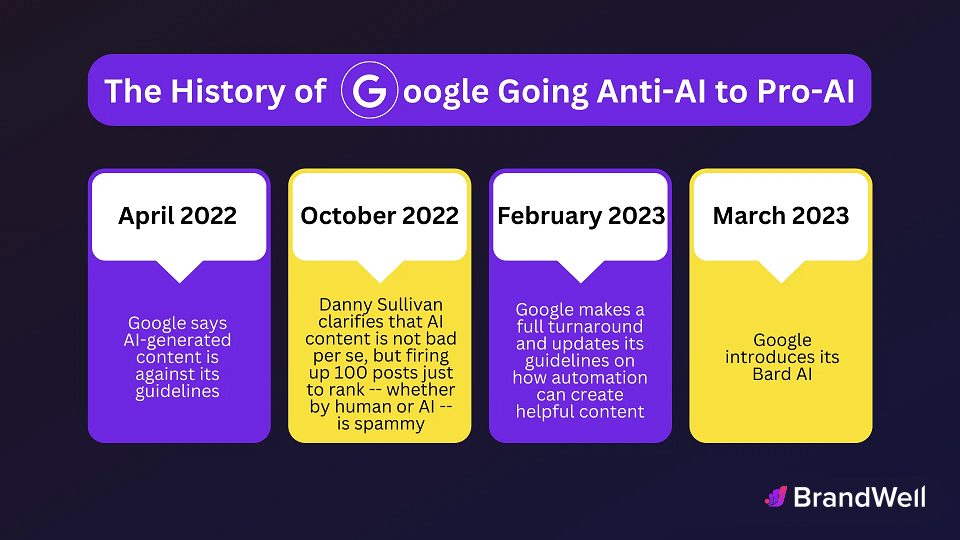
Google’s stance, for now, is that AI content itself won’t get your website penalized.
What Google does care about is whether your content is useful, original, and engaging, regardless of who or what created it.
So, can AI content be good for SEO in a way that aligns with Google’s guidelines?
Let’s explore this question further.
How to Make AI Content Work for Your SEO
While no one is saying to avoid using AI altogether, you need to get strategic about it.
Content is still king, even if a robot wrote some of it.
Think of AI as a superpowered assistant, not a replacement for human writers. You can use AI for tasks such as:
- Generating topic ideas.
- Researching keywords.
- Mining relevant statistics.
- Drawing images.
- Creating blog outlines.
Keep That Human Touch Front and Center
Editing AI-generated content is critical. Inject personality, add personal anecdotes, and refine anything that sounds clunky, repetitive, or just plain off.
Authenticity and original thinking will be how you win in a world where AI content is flooding search results.
If you’re asking: “Is AI content good for SEO?” The answer is yes, as long as you preserve a human touch.
Double-Check Everything: Research Is Still Your Job
AI writing tools pull information from various sources, which can be a problem if the info is inaccurate.
Clickbait, half-truths, and complete lies look the same to an AI as a peer-reviewed research paper. AI tools don’t necessarily understand what they’re reading.
It’s your job, as a marketer or content creator, to be extra diligent about fact-checking.
Make sure everything you publish is 100% accurate.
When dealing with potential bias in AI-generated content, verify information with sources from Google Scholar.
Watch Out for Plagiarism: Don’t Let AI Get You Sued
AI can unintentionally plagiarize.
A 2024 study found that 60% of ChatGPT responses contained plagiarism. While it might not be intentional, you could get flagged if Google detects your website’s content is a word-for-word copy.
Use a tool like Scite to check for proper citations and run your text through the BrandWell Plagiarism Checker to make sure your content is 100% original.
With the March 2024 core update, one of Google’s goals was reducing site reputation abuse.
So, is AI content good for SEO if there’s a risk it’s ripped off?
No. Plagiarism will harm your SEO because Google will deem your website untrustworthy if it detects that your content is copied from another source.
Always run all your AI-generated content through a plagiarism checker. Make necessary changes to ensure everything is original, and always cite your sources.
Read this comprehensive guide on how to humanize AI content so it doesn’t negatively impact your SEO.
Get Undetectable AI Content
AI tools continue to get better at generating written content. Specialized long-form writers like RankWell can produce blog posts that read more naturally!
If you’re using a generative AI model like ChatGPT to write your content, be sure to run your output through the BrandWell AI Detector first before publishing to make sure you are only putting 100% original content out there.
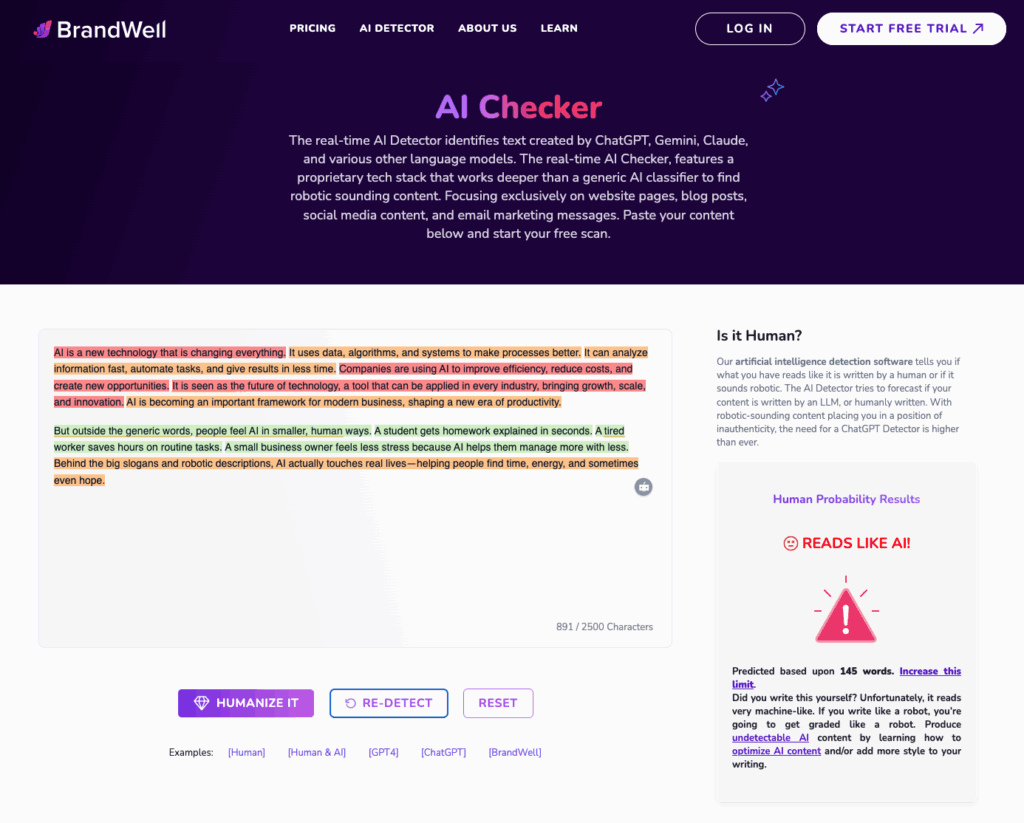
If your content reads like AI, you can manually rewrite these flagged sentences or subscribe to AI Detector Pro to get undetectable rewrites.
Use AI as a Tool, Not a Crutch
AI can significantly streamline content creation, but it should never replace human involvement. Instead, view AI as an assistant that simplifies your workflow while enhancing your creativity.
Always review and edit AI-generated content to ensure it meets standards of accuracy, quality, and originality.
While AI is excellent for generating ideas and drafting content, the final output should reflect human insights, experience, and a unique perspective. By combining the efficiency of AI with human expertise, you can produce high-quality, well-rounded content that resonates with both search engines and readers.
Let AI amplify your capabilities, but rely on your knowledge and creativity to deliver truly valuable and impactful content.
FAQs: Is AI Content Good for SEO?
Does AI content rank on Google?
Yes, AI-generated content can rank on Google. However, ranking consistently depends on various factors. These factors include content quality, relevance to search intent, proper keyword integration, and adherence to Google’s guidelines. Google focuses on the content itself being helpful, original, and user-friendly. They do not punish sites simply for utilizing AI writing tools.
Is AI content bad for SEO in 2025?
AI content isn’t inherently “bad” for SEO. However, simply using it without a strategic approach can backfire. Google’s algorithms are becoming increasingly sophisticated. They are getting better at detecting low-effort, spammy, AI-generated content. The key is to use AI tools strategically. Think of them as assistants in your content creation process rather than a replacement for human writers and strategists.
Google’s focus on factors like E-E-A-T means your human experience and expertise are more important than ever. These qualities are essential for successful SEO, even with the increasing prevalence of AI.
Is AI a threat to SEO?
AI isn’t necessarily a threat to SEO itself. Instead, AI has created a shift in the SEO landscape. The use of AI by search engines emphasizes high-quality, original, and helpful content above all else.
Instead of viewing AI as an adversary, view it as a tool. Those who learn to integrate AI tools effectively will be the most successful. Prioritizing human oversight and ingenuity in your content strategy will also lead to more favorable SEO outcomes. Those who can strike this balance will be best positioned for SEO success in the years to come.
Can Google detect AI SEO?
Although Google hasn’t revealed specifics on detecting AI-generated content, its systems are intelligent. Google can likely identify patterns, stylistic choices, and other characteristics often associated with AI content. These features can indicate automated or formulaic writing. While Google might not explicitly penalize for using AI writing tools, their algorithms emphasize certain factors. These factors include originality, depth of expertise, and human-like engagement.
Even if AI creates the initial draft, investing time in editing is crucial. Adding unique insights and refining the content to reflect the human experience are important steps in creating successful content.
Remember, Google’s focus is always evolving; producing high-quality, user-centric content should always be the primary goal. This is the best approach when it comes to SEO in 2025.
Is AI Content Good for SEO? Final Thoughts
AI writing tools can make your life easier when it comes to churning out content. However, the impact of AI content in SEO is only going to become more complicated in the future as Google’s algorithm evolves.
Transparency and clarity are key if you’re concerned about using AI-generated content and its implications for SEO in 2025.
Remember, over 52% of Americans are already feeling wary of AI, as this recent study shows, so the human touch isn’t just important for Google. It’s crucial for resonating with real-life people.
A growing number of businesses recognize AI’s potential: 83% of business leaders plan to invest heavily in AI over the coming months. While 63% cite AI’s tendency for errors and bias as a key concern, it’s a necessary risk.
The use of AI is becoming increasingly ubiquitous (as reported in this study). Balancing these tools with human oversight and insight will ultimately determine how Google views their use.
When marketers ask me, “Is AI content good for SEO”, it’s clear many hope it will be their secret shortcut to ranking higher than their competitors.
My honest take is that Google knows what it’s doing, and it’s getting smarter. While many jumped on the AI bandwagon last year, there are consequences if used unethically.

UNLOCK YOUR POTENTIAL
Long Headline that highlights Value Proposition of Lead Magnet
Grab a front row seat to our video masterclasses, interviews, case studies, tutorials, and guides.

